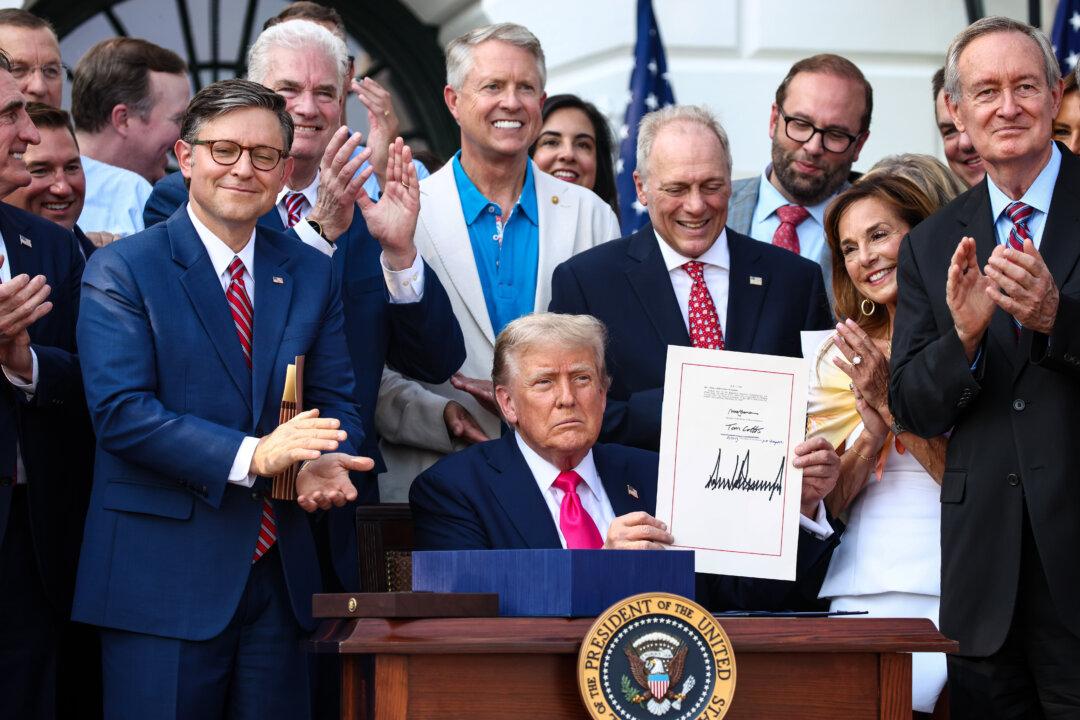WASHINGTON—President Donald Trump signed the One Big Beautiful Bill Act into law on July 4, celebrating both a major legislative victory and America’s Independence Day at a White House ceremony.
The signing took place at 5:45 p.m. during a military family picnic on the White House grounds. Two B-2 Spirit bombers from Whiteman Air Force Base, each escorted by a pair of F-35 fighter jets, performed a flyover during the signing ceremony.
House Speaker Mike Johnson (R-La.), Sen. Lindsey Graham (R-S.C.), Treasury Secretary Scott Bessent, Attorney General Pam Bondi, several other Cabinet members, and numerous Republican senators and members of Congress attended the event.
“It’s the most popular bill ever signed in the history of our country,” Trump said before signing the bill.
“We’re setting all sorts of economic records right now,” Trump said. “After this kicks in, our country is going to be a rocket ship, economically.”
The president also highlighted the success of a recent U.S. military operation targeting Iran’s nuclear facilities, describing it as “one of the most flawless military campaigns” in American history.
He invited 150 airmen and their families from Whiteman Air Force Base in Missouri, home of the B2 bombers, to the White House signing ceremony.
The bill marks a major political victory for Trump, allowing him to advance much of his domestic agenda.
The historic bill came after weeks of intense negotiations within the Republican Party and between the House and Senate. It includes making the 2017 tax cuts permanent, providing tax breaks on tips, overtime, and Social Security income, funding the completion of the border wall, allocating $150 billion for defense spending, and repealing so-called green energy tax credits.

Permanent Extension of 2017 Tax Cuts
The centerpiece of the legislation is permanently extending the lower individual income tax rates introduced in the 2017 Tax Cuts and Jobs Act.Increased Child Tax Credit
The bill boosts the child tax credit from $2,000 to $2,200 per child and makes the credit permanent.Tax Relief on Tips, Overtime, and Auto Loans
The bill implements some of Trump’s core campaign promises on tax policy, cutting taxes on tips, overtime pay, and auto loans.$6,000 Social Security Deduction for Seniors
The legislation provides seniors with a $6,000 deduction on their Social Security income. However, this benefit phases out for individuals earning over $75,000 and couples earning more than $150,000.Major Funding for Border Security
The legislation allocates $150 billion to support immigration enforcement in line with key promises from Trump’s campaign.This includes nearly $30 billion for Immigration and Customs Enforcement (ICE), the agency leading the administration’s mass deportation program. An additional $13.5 billion in grants is set aside for state and local governments that support these operations.
Defense Spending
The bill appropriates $157 billion for defense, with $29 billion going toward enhancing U.S. maritime capabilities and shipbuilding, $25 billion slated for munitions, and $25 billion dedicated to the “Golden Dome“ missile defense project.Cuts to Clean Energy Tax Credits
Several clean energy tax credits established under the Inflation Reduction Act are being cut, beginning as early as 2025.The electric vehicle tax credit is scheduled to end on Sept. 30.
Medicaid and Rural Hospitals
The bill seeks to curb Medicaid spending by imposing an 80-hour monthly work requirement for able-bodied adults to receive benefits.It also lowers the “provider tax”—the rate at which states tax hospitals and doctors to pay for their Medicaid programs—from 6 percent to 3.5 percent in states that expanded Medicaid under the Affordable Care Act. Ten states that didn’t expand their programs will see no changes.
To offset fears that these changes would harm rural hospitals, the bill allocates $50 billion in support for such hospitals.
SNAP Cuts
For the first time, the bill would require states to contribute to the Supplemental Nutrition Assistance Program (SNAP), also known as food stamps.States would be responsible for covering between 5 percent and 15 percent of benefit costs, depending on their payment error rates.
Alaska and Hawaii could seek a waiver from this requirement if they demonstrate a good-faith effort to reduce their errors.
$5 Trillion Debt Ceiling Increase
The bill includes a $5 trillion increase to the U.S. debt ceiling. This provision is one of the most pressing items in the bill as the Treasury nears a potential default in the coming months.Expanded SALT Deduction Cap
The bill raises the state and local tax (SALT) deduction cap from the current $10,000 limit set by the 2017 Tax Cuts and Jobs Act.The new cap would rise to $40,000 per year, with a 1 percent increase annually over the next five years. Beginning in 2030, the cap would return to $10,000.
Education Policy Changes
The bill reduces Pell Grant eligibility for high-income students and students with a full ride. It also introduces two federal student loan repayment plans, including one traditional repayment plan and one income-based repayment plan.Additionally, it would tax college and university endowments at a variable rate—either 1.4 percent, 4 percent, or 8 percent—based on the institutions’ wealth.






